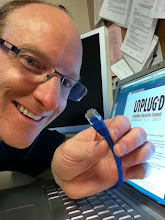 While educators are aware that they have great responsiblity to teach content and skills to learners of all ages, we are mostly unaware that we are providing reflections of ourselves to 'the machine' each time we use the World Wide Web'.
While educators are aware that they have great responsiblity to teach content and skills to learners of all ages, we are mostly unaware that we are providing reflections of ourselves to 'the machine' each time we use the World Wide Web'.I first happened upon the phrase "Teaching the Machine" in Michael Wesch's Video: Web 2.0... The Machine is Us/ing Us. Just past the half way mark of the video, an article that I'd read many months earlier, is referenced. The Web version of "We are the Web", first published in Wired Magazine in August 2005, remains timely in helping us understanding our role in 'wiring' the neural networks of the World Wide Web:
"...And who will write the software that makes this contraption useful and productive? We will. In fact, we’re already doing it, each of us, every day. When we post and then tag pictures on the community photo album Flickr, we are teaching the Machine to give names to images. The thickening links between caption and picture form a neural net that can learn."
It was earlier this afternoon that I experienced how quickly the machine can learn. In uploading a batch of outdoor auto show photos I'd taken two years ago, I taught the machine by adding appropriate filenames and tags to each of the images. Although time has yet to provide me the liberty to provide more descriptive detail, by zooming in and clicking on a global map, I was also able to plot the location where I'd taken these photographs.
What I didn't realize, is that I also taught the machine by providing metadata that was included in the image files themselves. Flickr now knows the camera I used, and the dates/times the photos were taken. The once amazing ideas shared almost a year ago in the Photosynth Talk at TED, suddenly seem all the more real and personal to me:
Teaching the machine about images, is only part of the role we all play in teaching the machine. In the next few days, I'll be trying a focused thought experiment to consider what we teach it when:
1] we link to ideas;
2] we define words and ideas in Wikipedia;
3] we refine searches in 'Google'; and by following the 'right' link, provide feedback to the machine;
4] we play, then win or lose at games like chess or Texas Hold 'em;
5] we make online purchases;
6] we send and receive text messages, tweets, and email to members of our networks...
When the morning arrives, I'll begin expanding on these ideas via the Teacher 2.0 Podcast.




0 comments:
Post a Comment